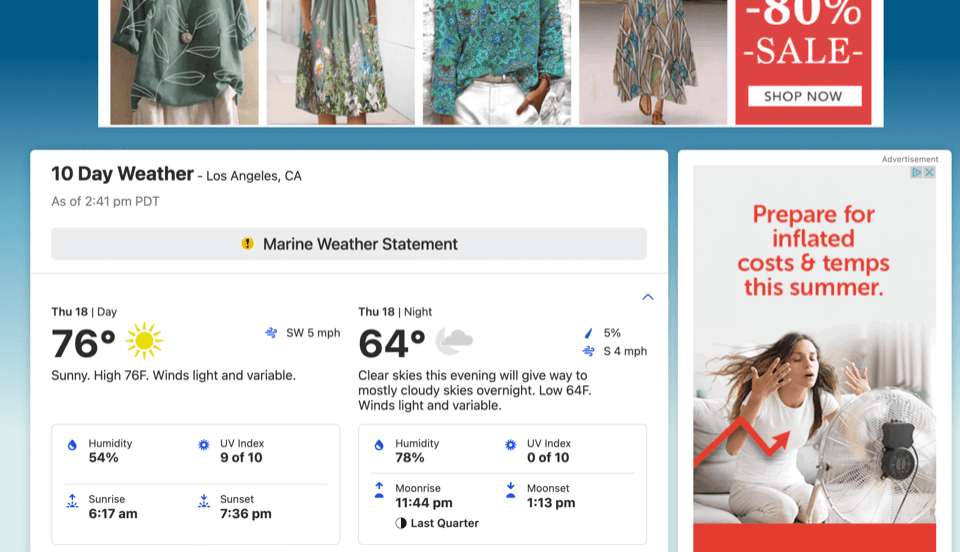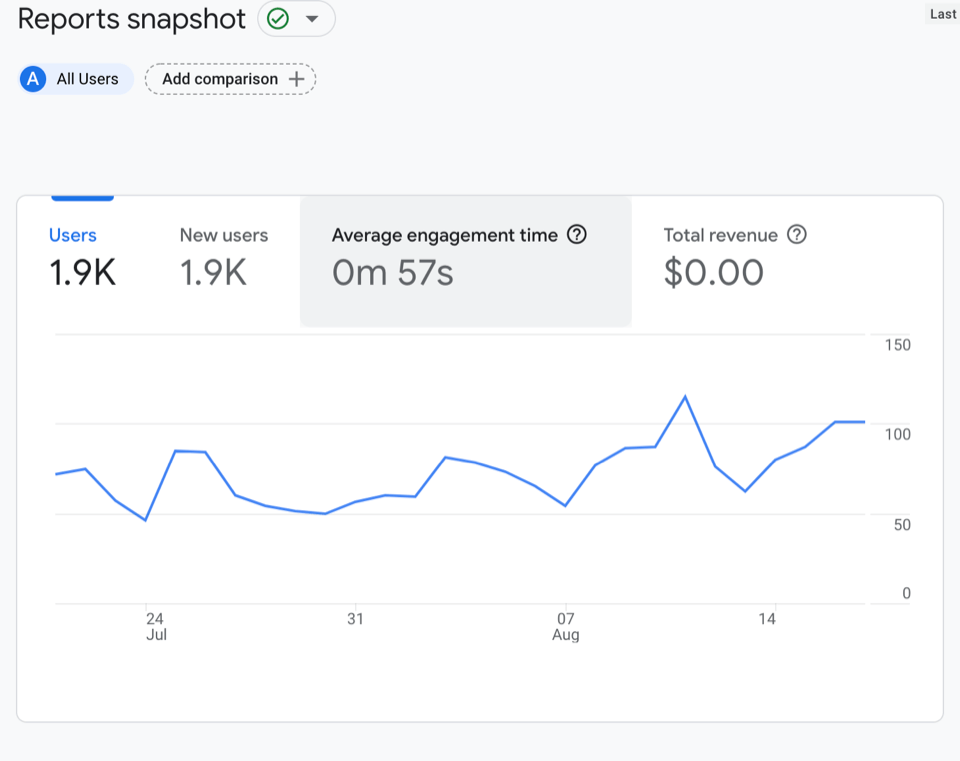Website analytics give valuable insights into consumer behavior and help you tailor your site experience to compel users to stay. While most analytics tools will tell you a page’s bounce rate, many business owners dismiss or misinterpret this statistic. It’s not always obvious what a “good” bounce rate is or what steps you’d need to take to improve it.
This comprehensive guide will walk you through everything you need to know about bounce rates and how to improve them. Understanding this key concept can transform your approach to web design and content strategy, ultimately leading to higher conversions on your site.
What Is Bounce Rate?
SEO includes many on-page factors from keywords to title tags to image optimization, but, in many ways, bounce rate is the judge of how well your page appeals to your audience.
A “bounce” is when a user visits a webpage and leaves without taking any action. Think of a bouncer at a club—only in this case, the user decides to leave on their own.
Bounce rate is slightly different than exit rate, which is a measure of how many people end their session on a particular page. If someone visits your site, spends 20 minutes reading different resources, and then eventually clicks away to a different site, that’s an exit. A bounce is a single-page session, usually when a user quickly realizes that a page is not what they’re looking for, and they hit the back arrow to return to the referring page.
Because many people interpret bounces as user disinterest, webmasters generally want low bounce rates. Improving a bounce rate means a higher percentage of users continue their session by clicking to another page on the site.
What Is the Average Bounce Rate?
Many marketers just want a number—what’s a good bounce rate? It partly depends on your industry. For example, those in real estate may experience an average bounce rate of about 44%, while those operating a food and drink website might see an average bounce rate of 65%. There is no one magic number that defines a good rate. Although it’s helpful to consider an average bounce rate of around 41-55%, context is everything.
Some types of pages will naturally have a high bounce rate. For example, if you visit a website just to check the weather forecast or you simply need to look up a business’s phone number, you will most likely bounce after you’ve found the information you needed—but that doesn’t mean the page was poorly designed or that it failed to reach its intended audience. In some cases, a high bounce rate could just mean that the page clearly and efficiently directs users to the information they were looking for.

This page gives users a clear answer to a simple question—what’s the weather forecast for Los Angeles today? Advertisements can be a form of revenue generation as this type of page is less likely to move users to another stage of the sales funnel.
On the other hand, if a landing page that’s supposed to be directing users to the next step of the sales funnel has a bounce rate of 95%, something has gone very wrong. A too low bounce rate can also be a cause for concern. SEO is all about driving organic traffic, so what your bounce rate is can help you determine if you’re actually reaching new users.
For instance, a bounce rate of 0% is statistically unlikely if you’re organically reaching new users (naturally, some people will click away no matter how well designed your page is). So 0% either means your tracking hasn’t been set up correctly, or it means you have a very small, loyal following of the same people who read your site every day.
Improving your bounce rate should focus on getting the number below 40% in most cases, realizing that some bounces are actually a positive sign of new organic traffic.
Choosing the Right Focus
Remember that average bounce rates can vary wildly, and high bounce rates aren’t always a cause for concern. Take a news article, for example. This sort of page will naturally have a high bounce rate because many users will come for the headline, read the information, and leave. A closer look at the average duration of each user session can give you some confidence. If, on average, users spent 5 minutes on the page, that likely means they were reading the information and finding it valuable. It helps to know what your audience wants. Perhaps a single page does meet a need for your users and achieve a goal for your business.

A Google Analytics report can help you identify the average engagement time on a page.
But what is a valuable metric for SEO is the bounce rate on landing pages. Analyzing landing pages is one of the best ways to attribute revenue from SEO work, and a series of poorly performing pages can reveal major flaws in your strategy. If the page is intended to pique user interest and drive further engagement or conversions, something isn’t working when a majority of users bounce away.
How Can I Improve Current Bounce Rates on My Website?
Higher bounce rates can indicate that your website is not effective at promoting a certain kind of action or that there’s something inherently wrong with your website that’s driving prospective users away. No matter the reason, here are a few ways you can address this.
Site Speed
Everyone’s had that experience of a never-ending loading bar or spinning circle that leads to frustration and giving up. And it doesn’t take long for users to quit on a slow-loading site. According to Google, the probability of bounce goes up to 90 percent as site loading speeds go from one second to five seconds.
From simple fixes like compressing images to running a full performance diagnostic, make sure your site loads quickly. You may want to avoid carousels, sliders, and other dynamic elements, and make sure to choose a lightweight theme. Speeding up your site even a little bit will help improve bounce rates.
Design
Poor navigation, confusing layout, outdated graphics—these all have one thing in common. If your site is poorly designed or ugly to look at, most users won’t want to stick around. Website experience is one of Google’s key SEO factors, and the bounce rate is what can tell you that users are not having an easy time.
Follow best practices like a clear navigation bar and frequent call-to-action (CTA) buttons. Use a consistent color scheme that fits with your branding so users will recognize the site and trust it. Lastly, be choosy about your images. Insert photos and illustrations that look attractive and speak to your audience. Don’t use an image just to take up space. Many highly successful landing pages have few pictures—decide if you truly need an image before placing it.

A concise call to action with a simple layout. Notice the clear navigation bar, readable font, and CTA button. Design-heavy pages aren’t always necessary.
Mobile Responsiveness
Improving bounce rates means optimizing for mobile users. Remember to craft the perfect web experience for both your desktop and mobile users, but especially consider mobile users when making layout decisions. It’s harder to read small text on a phone screen, and it’s easier for users to tap a button and return to the previous page. In other words, users will have less patience on mobile and may bounce sooner if they can’t find what they need.
Test your page extensively on mobile devices and make sure there are no broken lines of text, odd displays, or other barriers to someone engaging with your content.
Optimized Content
If you’re confident that the layout isn’t the problem, improving your content may be the best way to lower your bounce rate. Consider search intent, conversational keywords, and schema. For instance, if you’re hoping that users will purchase a product, make sure you’re targeting transactional keywords and highlighting the benefits of that particular product on the page.
Give users plenty of opportunities to move to the next step. If someone searches for rental cars and can’t immediately find the place to rent a car on your website, they’ll likely bounce, even if you offer that service. A landing page intended for conversions would not be the place to share your company history, for instance.
Bad Referring Links
While backlinks are an important part of an SEO strategy, they may be a contributing factor to what is causing your high bounce rate. If a high-traffic website refers users to your page who aren’t actively searching for your service or product, they will likely bounce.
Or, in some cases, users will bounce simply because they already found what they needed. If your page offers a quick resource or definition, referral traffic may come quickly to find the answer they need, then go back to the page they were originally reading.
There isn’t much you can do to improve a bounce rate if it’s caused by a referring link, so the important thing here is to remember that context is key. If you identify in your analytics that a referring site is sending a high volume of traffic to a page that also has a high bounce rate, you may decide that your initial concerns were overblown.
Acting On Your Findings
In summary, bounce rate is an important statistic, but it requires interpretation.
Improving bounce rates should be part of your continuous SEO monitoring and strategy. The more information you can uncover about why users bounce from a page, the better informed you’ll be to make necessary changes.
It can be challenging to stay on top of algorithm updates and properly update numerous landing pages for your site. Working with an SEO service company can help you unlock key insights from your analytics data and pursue the right work to maximize traffic and grow your business.

